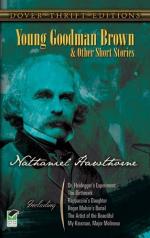|
This section contains 2,766 words (approx. 10 pages at 300 words per page) |

|
SOURCE: 'The Woe That Is Madness: Goodman Brown and the Face of the Fire," in The Nathaniel Hawthorne Journal 1973, edited by C. E. Frazer Clark, Jr., Microcard Editions Books, 1973, pp. 177-82.
In the following essay, Morsberger contends that Goodman Brown's loss of faith in others reflects the beginnings of American political and social paranoia.
Hawthorne, if any one, was equipped to write the definitive novel on the Salem witchcraft delusion; but he never confronted it head on. "Alice Doane's Appeal" conjures up the victims from the graveyard, Grandfather's Chair and "Main Street" give the barest bones of a synopsis, "Sir William Phips" merely hints at it, and The House of the Seven Gables fictionalizes its heritage of guilt. But nowhere does Hawthorne give the dramatic account in depth of the trial and tragedy of Rebecca Nurse, George Burroughs, John Proctor, Giles Corey, George Jacobs and the other courageous...
|
This section contains 2,766 words (approx. 10 pages at 300 words per page) |

|


